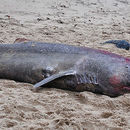en
names in breadcrumbs


Greenland sharks are also known as sleeper sharks, ground sharks, gray sharks, and gurry sharks. They are known as ekalugssuak in Greenland, hakarl in Iceland, and hakjerring in Norway.
Like all sharks, Somniosus microcephalus has a lateral line which aids in the detection of movement in the surrounding waters. Sharks also have especially keen chemical perception. No communication has been observed within the species.
Perception Channels: tactile ; vibrations ; chemical ; electric
The status of Greenland shark populations are not well known. They support a fishery for liver oil in Greenland, Norway, and Iceland, but some researcher suspect that populations have diminished. They have an estimated population doubling time of 14 years.
US Federal List: no special status
CITES: no special status
IUCN Red List of Threatened Species: near threatened
Development in Somniosus microcephalus is ovoviviparous; litters of up to ten pups have been observed. Size of fully grown young at birth has not been confirmed but is thought to be around forty centimeters. Most adults grow to between two and four meters in length.
Unless properly washed or dried, Greenland shark meat is toxic to humans. Like most sharks, Greenland sharks rarely attack unless harassed.
Somniosus microcephalus is commonly fished by people in the Arctic regions (Norway, Iceland, and Greenland) for its liver oil and meat. People of the Inuit tribes have also been known to use its skin to make boots and its teeth as knives.
Positive Impacts: food ; body parts are source of valuable material
Many of these sharks have copepod parasites, Ommatokoita elongata, attached to the corneas of their eyes. A single, female copepod will attach itself to one of the corneas, resulting in corneal damage and blindness in one eye. This does not seem to negatively effect the shark, as they do not rely on their vision. It has been suggested that the bioluminescence of these parasites helps lure prey, thus resulting in a mutualistic relationship, but there is no evidence to support this.
Mutualist Species:
Fish, marine mammals, and carrion are three staples in the diet of Somniosus microcephalus. Fish include herring (Clupeinae), salmon (Salmonidae), smelt (Osmeridae), cod (Gadidae), pollock (Theragra), haddock (Melanogrammus), halibut (Hippoglossus), redfish (Hoplostethus), sculpins (Cottoidei), lumpfish (Cyclopterus), and skates (Rajiformes). Seals (Phocidae) and small whales (Delphinidae) are also common food items. Drowned horses and reindeer have also been found in the stomachs of captured specimens. Somniosus microcephalus has been observed feeding in great numbers on carrion produced by commercial whaling and fishing operations.
Animal Foods: mammals; fish; carrion ; mollusks; aquatic crustaceans; echinoderms; cnidarians
Primary Diet: carnivore (Piscivore )
Somniosus microcephalus is found in the north Atlantic, from the coast of New England and Canada to Scandinavian waters. They occasionally venture as far south as the mouth of the Seine River in France.
Biogeographic Regions: atlantic ocean (Native )
Somniosus microcephalus live mainly on continental and insular shelves. They occupy intertidal regions in addition to some river mouths and shallow bay areas during the winter months and often move to depths from 180 to 550 meters during warmer months. They have been observed as low as 1200 meters, with one observation at 2200 meters off the coast of Georgia - extending its range both geographically and in terms of depth. In northern parts of their range, Greenland sharks are found from 0 to 1200 meters in waters from 1 to 12 degrees Celsius. In southern parts of their range, these sharks may occur at greater depths.
Range depth: 145 to 1200 m.
Average depth: 180-550 m.
Habitat Regions: temperate ; polar ; saltwater or marine
Aquatic Biomes: pelagic ; coastal
Other Habitat Features: estuarine ; intertidal or littoral
No specific information about the longevity of Somniosus microcephalus exists. Some scientists speculate that these sharks may live in excess of 100 years.
Somniosus microcephalus is a large, sluggish shark that averages between 2 and 4 meters in length. Most of the body is a medium grey or brown in color and sometimes exhibits dark transverse bands or small spots or blotches that are lighter or darker than the base color. The snout is short and rounded, and the body is heavy and cylindrical in shape with small precaudal fins. No spines are present in the two equally-sized dorsal fins, and the ventral lobe of the caudal fin is slightly elongated. No anal fin is present. The skin is quite rough, exhibiting denticles with curved pointed cusps. Teeth in the upper and lower jaws differ in shape; upper teeth are spear-shaped while the lower teeth are shaped with high roots and low bent cusps for slicing.
Range mass: 700 to 1000 kg.
Range length: 40 to 640 cm.
Average length: 244 to 427 cm.
Other Physical Features: ectothermic ; heterothermic ; bilateral symmetry
Sexual Dimorphism: female larger; sexes shaped differently
There are no known predators of adult Greenland sharks because of their very large size.
Mating by this species has never been observed, but females have been found with mating scars on their caudal fins. Therefore, it is inferred that, as is the case with most sharks, males bite females until they submit. Fertilization occurs internally.
Mating System: polygynandrous (promiscuous)
Mating has never been observed in this species and little information is available concerning reproduction in Greenland sharks or related species.
Average number of offspring: 10.
Key Reproductive Features: iteroparous ; gonochoric/gonochoristic/dioecious (sexes separate); sexual ; fertilization (Internal ); ovoviviparous
There is no specific information on parental investment in Greenland sharks. However, most sharks are independent immediately after birth. Females provide developing embryos with rich food sources to support their development.
Parental Investment: pre-fertilization (Provisioning, Protecting: Female); pre-hatching/birth (Provisioning: Female)